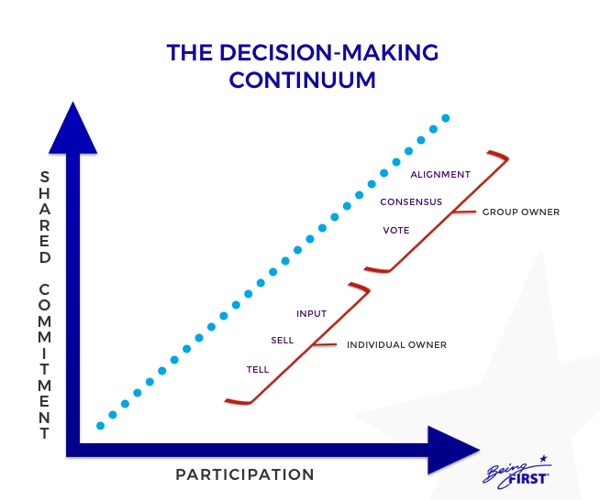One of the most common factors in the failure of transformational change is dysfunctional decision-making. How can something so seemingly simple be such an impairment to the effectiveness and progress of change?
When decision-making roles, style and process are not clear, they trigger confusion, conflict, political power plays, information-withholding, loss of focus and lack of action.
If your decision-making style is contrary to the culture and behavior your transformation is intending to generate, you lose credibility and create cynicism. When you are intentional about setting up appropriate decision-making at the launch of a transformational effort, you start with a foundation of clarity, alignment and effectiveness, right from the get-go!
Let’s look at how to do this.
Good Change Governance Starts with Clear Decision-Making Roles and Authorities
Most organizations use a RACI or RAPIDS model, or something similar, to clarify decision-making roles. Any of these will do fine if you are clear about which change leadership roles have which type and level of authority.
Who has responsibility to generate a decision about the change strategy, outcome or plan? Who has the accountability and therefore, the veto power? Who gets to make the decision, and who inputs to it or is informed once a decision is made? These are essential roles to clarify, and should be distributed appropriately among your sponsor, change process leader or project lead, project team members, change consultants and content experts.
Assigning roles will be dependent on the type of decision being made. For example, deciding on the preferred new state design will have different role assignments than determining the best engagement strategy for any particular stakeholder group. When you outline your change strategy and plan, determine the types of decisions required and assign roles as needed. This need not be done all at once since so many decisions emerge along the way. Just do it in advance of starting the decision-making process.
Choose a Decision-Making Style that Models Your Intended Future State Culture
Change leaders can use a multitude of decision-making styles, from the traditional command-and-control approach where the leader makes the decision and informs others who must then follow, to a collaborative and participatory approach where stakeholders are involved or have influence, and the decision is made jointly. The graphic below defines six style options along such a continuum. Note that the farther up and to the right of the continuum you go, the greater the commitment and participation generated.
Individual Owner
Tell: I make the decision without input or explanation.
Sell: I make the decision and tell you the reasons why so you will accept it.
Input: I make the decision after hearing from others.
Group Owner
Vote: Group vote, designated percentage or quorum wins.
Consensus: We all agree about how to proceed, even though some of us think a different decision might be better.
Alignment: We all enthusiastically agree this is the very best decision.
The power of decision-making styles is that they need to represent and reinforce the culture, mindset and behavior that your transformation is striving to create in the organization. A “Tell” style will not do for a desired culture that aims at greater engagement! Be conscious of the style you need to drive your transformation and make it overt before you engage in discussing any decision.
Ensure that your change leaders and project teams adopt a standard operating procedure of naming the decision roles, style and process. This makes them great models to others.
Why an Effective Decision-Making Process is Essential
The identification of roles is not adequate to ensure a good decision is made or its outcome achieved. The decision-making process is equally important to clarify for successful transformation.
The following decision-making process is effective and helps ensure that everyone involved in the decision understands the scope of the decision, who owns it (as well as the other roles), what style will be used to determine it and how to follow through to ensure it gets implemented. This particular process also ensures that people consider the impacts of the decision as a part of making it.
- Clarify the purpose and scope of the decision being made.
- Identify the person who “owns” the decision and has the authority to decide the decision-making roles, style and process.
- Overtly announce the decision-making roles, style and process.
- Depending on the decision style, discuss potential options for the decision outcome.
- Identify the impacts of the decision options before making the decision.
- Assess impacts from the perspective of what is best for the overall organization or the transformation’s outcomes.
- Make the decision in the style selected.
- Identify accountabilities and next steps regarding implementation of the decision.
- Overtly summarize the decision, accountabilities, and next steps.
- Openly state commitment to the decision and its implementation plan.
Related Video:
The Importance and Value of Transformational Change Governance
In this snippet from our online program, Leading Transformational Change, Dr. Linda Ackerman Anderson explores the value of effective transformational change governance and why significant shifts are needed in sponsors, change leaders and executives when launching and leading transformational change projects.
Related eBook:
The Ten Key Strategies for Leading Transformation

Through 40 years of observing and supporting large-scale change and transformation in Fortune 500, government, global NGOs and public service organizations, we’ve identified these ten Best Practice strategies for leading transformation successfully.
Please complete the form to download your eBook:


